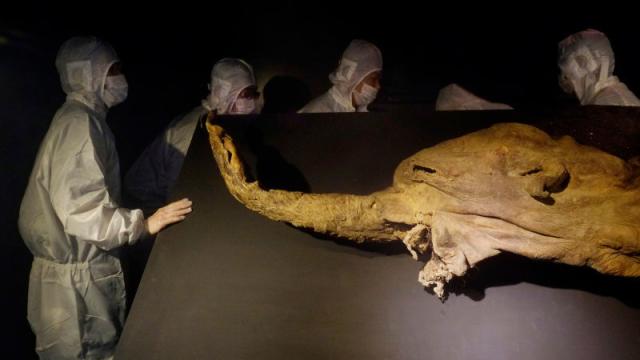In the early 20th century, seeking riches, fur and its medicinal qualities, the people of Europe hunted the Eurasian beaver to near extinction. Clever scientists, though, had an idea of how to atone for their sins. The North American beaver, at least from the outside, seemed nearly identical. They would introduce this far-flung cousin to Europe in hopes that it would breed and help restore the population.
Image: AP
There was just one, fairly giant hitch: The two beavers were actually two separate species, and they were not genetically compatible. One had 40 chromosomes, the other had 48. They had unwittingly introduced an invasive species, and one that could not help them restore their own dwindling beaver population.
Today, as scientists mull using genetics to bring back everything from the long-gone woolly mammoth to the more recently smote heath hen, some have raised an intriguing question: If you raise an animal from extinction, is it really the same animal as the one that went extinct? And if it isn’t, could there be consequences, just as early 20th century Europeans found with the North American beaver?
“A lot of people have discussed the technology, whether or not it’s actually possible to make a species no longer extinct, but we for the first time are thinking about the consequences of that,” Axel Hochkirch, a biologist at Trier University in Germany, told Gizmodo. “Even if we could completely restore the genome there would still be some differences in things like learned behaviour, epigenetics and microbiome. That leaves a lot of uncertainties.”
There are multiple methods scientists are pursuing in order to accomplish bringing extinct species back to life. Scientists have already used cloning to restore, for a few brief minutes, the Pyrenean ibex, a method that relies on using the nucleus of the somatic cell of an extinct species and transferring it into the germ cell of a host species. Another method (the one being used to resurrect the woolly mammoth) involves using genome engineering to create a hybrid organism using available parts of the extinct species genome and genetic information from a closely related surrogate to fill in the gaps. Any way you slice it, in other words, a resurrected species would contain at least a small amount of genetic information from another species entirely.
In a set of “de-extinction guidelines” published last year by the International Union for Conservation of Nature, this fact led the body to go as far as calling them “proxy species” rather than “de-extinct”.
“Proxies of extinct species might constitute novel species by having unfamiliar ecological traits and being non-resident (having no recent evolutionary history) in a release area,” the guidelines explained.
Whether due to genetics alone or ecological and environmental changes since extinction, the guidelines warned that how a de-extinct species would behave in the wild could be hard to predict.
It continued: “A proxy species might become invasive if its establishment and growth causes damage to the environment, or to human economy or health. The negative effects of the proxy species might appear only long after its release into the wild.”
In a paper out this week in the journal Science, Hochkirch and colleagues argue that these considerations, combined with legal ambiguities of how a extinct species might be categorised, call for naming them something else entirely.
“There’s a lot of legal uncertainties,” he told Gizmodo. “The name of a species, for example, is quite crucial in conservation legislation. So it might be beneficial to name it something else, or at least to give it a clear label as a de-extinct species.”
If a species is endangered, for example, and then hundreds of a de-extincted version of it are released into the wild, you wouldn’t want those numbers to jeopardise the animal’s protected status. Likewise, if you were to release it, you might want it to have to undergo some of the same scrutiny that genetically modified organisms are subject to. In all accounts, he said, it could be important to distinguish a natural species from a de-extinct one in the eyes of the law.
Harvard geneticist George Church — the man behind the woolly mammoth project — disagreed though, that a de-extinct species would be something so entirely novel. He pointed to the grey wolf, which went extinct in their native habitats but were eventually reintroduced.
“The environment had changed radically and the reintroduction went fine,” he told Gizmodo. “I’m not saying it’s always going to work out, but there are already test cases out there.”
The grey wolf reintroduction, in fact, did have an impact on the local ecology, which scientists are still studying, but much of that impact seems to be for the better, like a growing local beaver population.
Church isn’t against calling the de-extinct animals something new, but he’s less certain it’s necessary. Changes to the environment like food sources can produce similar changes in animals that the IUCN guidelines raise and its rare that two members of a species are perfect copies to begin with. It also raises more complicated questions, such as at what point an animal becomes a hybrid — if that woolly mammoth has 90 per cent woolly mammoth DNA is it still a woolly mammoth, or 60 per cent?
What is clear is that de-extinction raises many, many complicated questions even as it may provide a way to conserve threatened species.
“Success with this technology could be years or decades away,” Hochkirch said, “but its important to discuss these things now.”
